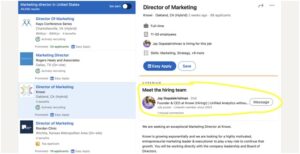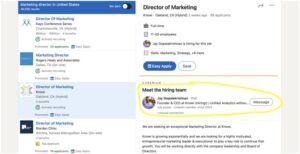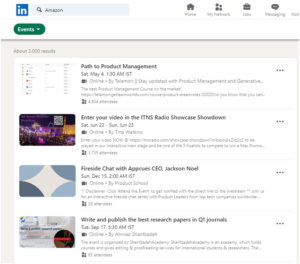Introduction
Today, LinkedIn has become the go-to platform for professionals, whether to connect with like-minded people, showcase their achievements, or look for their dream jobs. But beneath the surface of profiles and job postings lies a hidden potential – a valuable repository of competitor intelligence. By strategically mining LinkedIn data, you can unlock valuable insights into your competitors’ strategies, talent acquisition methods, and market positioning. These insights, when sourced ethically and legally, can be a game-changer for your business. In this blog, we will explore the significance of competitor intelligence and factors to consider before implementing LinkedIn data mining services for the same. We will also discuss a few LinkedIn data mining strategies you can implement.
How does competitor intelligence contribute to business success?
Gaining competitor intelligence is the practice of collecting and analyzing information about your competitors and the industry. This can benefit your business in the following ways:
- Acquiring and retaining talent: Data from competitor employee profiles can provide insights into industry-relevant skill sets, required years of experience, and approximate salary ranges. This information is fundamental to talent acquisition and retention within your company.
- Improving sales and marketing efforts: Tracking your competitor’s campaign effectiveness via engagement metrics such as likes, comments, and shares enables you to point out themes and formats that work better with your target audience. With this knowledge, you can create unique campaigns to target the right consumer segment while maintaining relevance.
- Proactive advantage: By implementing competitor market research, you can gain insights into competitor product launches, events, and other initiatives. This empowers you to anticipate their future actions and adapt your strategies accordingly.
- Expansion: Competitor intelligence allows you to gauge consumer sentiment and identify potential areas of expansion. Additionally, competitor intelligence data can also flag market saturation by revealing factors such as a high number of competitors offering similar products, declining profit margins, and difficulty in gaining market share. Based on this knowledge, you can adjust your presence in different markets.
Things to consider before implementing LinkedIn data mining services for competitor intelligence
Here are a few things to consider before you begin using LinkedIn for competitive intelligence.
-
Define your objectives
Before you begin, you must know exactly what you want to achieve by gathering competitor data from LinkedIn. Are you looking to learn about their latest products and marketing strategies, or are you interested in knowing the themes they discuss? Having specific goals can help you focus on what’s most important.
-
Survey internal teams to assess what specific data they want
Brainstorm with relevant teams to build on your competitor analysis goals. Each team brings unique perspectives and may have a different requirement for competitor data. For instance, your marketing team may prioritize insights into a competitor’s audience’s areas of interest over their current designation. So, internal surveys should be conducted to determine what additional data is required.
-
Figure how you will track, store, and share this data
It is imperative to figure out a channel for information flow before implementing LinkedIn data mining. Consider how you will track profiles, where you will store this data, and, most importantly, how you’ll share it with the relevant teams. Without a clear channel in place, you risk losing valuable insights, compromising the overall effectiveness of your strategy.
Top strategies to use LinkedIn data mining for competitor intelligence?
Now that your goals are clear, here are a few ways to utilize LinkedIn for competitive intelligence.
-
Locate decision-makers such as CEOs, CFOs, etc.
Use LinkedIn’s advanced search to target people in relevant industries, such as engineering or IT.

As you can see, there are numerous filters (people, products, jobs, posts, groups, and so on) to refine your search.
Start by entering your competitor’s name in the “Companies” field of the advanced search bar. You can refine your search by adding filters such as Title, Current Company, Past Company, etc., to spot specific people (CEO, CFT, CFO, etc). Once you have a list of those who meet your filtering criteria, analyze their profiles and gather data on company switches, updated contact information, email addresses, work locations, social media profiles, etc.
Note: Analyzing C-suite profiles through Past and Current Company filters enables you to track the movement of employees between two organizations. This insight can reflect their talent acquisition capabilities and highlight potential partnerships.
-
Examine their profiles to gain an overview of influential people within your industry
Track past and current job titles, affiliations, new achievements, or recommendations on their profile. This data can offer valuable insights into their career progression within your competitor’s company. Additionally, analyze their connections to understand their professional network and explore the groups and discussions they participate in. After conducting this analysis on executives from various companies, perform a comparative study to uncover commonalities and differences to get an overview of influential people within your industry.
-
Monitor LinkedIn company pages to see the kind of jobs they offer
Monitor LinkedIn company pages. They are akin to a company’s home base, hosting a vast amount of information showcasing their brand (basic details like industry, size, location, etc.), recent updates (news, announcements, etc), career opportunities, products and services, and more. Check out the Jobs section on your competitor’s company page to see what positions are currently vacant. Additionally, if you have a premium/business account, you can further refine your search by accessing features like Meet the Hiring Team.

Analyzing competitor job postings on LinkedIn can give you a peek into their talent strategy. You can identify the specific job titles, areas of expertise, and skills they seek, revealing their focus and potential upcoming projects. While not always, some postings may also offer clues about salary ranges and benefits, with the number of applicants hinting at compensation and HR data.

Note: A high frequency of postings for the same role on your competitor’s LinkedIn page can signal internal challenges in recruiting and retaining employees for those positions. Analyzing this data over time could help you gauge overall employee turnover and, hence, their stability.
-
Use data from LinkedIn Event Pages to track competitors’ events
You can search for any upcoming event by typing in your competitor’s name and then filtering the results by using the Events button. Once you have a list of relevant upcoming events, begin your analysis. Pay attention to how people are engaging with their event announcements (in terms of likes, comments, and shares).

Additionally, look for recurring themes, topics, and unique selling propositions (USPs) when mining LinkedIn data. Analyze attendee lists of industry events they host or participate in. These lists can reveal potential customers interested in themes that align with your business. And not just this, if suitable, consider attending the event to experience their content and interactions firsthand.
Pitfalls of implementing LinkedIn data mining on your own
While LinkedIn data mining itself isn’t inherently risky, taking shortcuts can cause legal repercussions. LinkedIn strictly prohibits scraping user data using automated tools or bots. If you try to go this route, you may risk account suspension or even legal action. An excellent way to prevent this is to opt for professional LinkedIn data mining services. These service providers implement measures to ensure compliance with all relevant laws and regulations, including LinkedIn’s terms of service. Moreover, they have expertise in sourcing only the most relevant and publicly available information without violating user privacy.
Final verdict
LinkedIn is now a preferred source of competitor intelligence because its public data provides insights into your industry’s current state, the activities of prominent leaders, and even a sneak peek at rival tactics. However, the success of using LinkedIn data mining for competitor intelligence depends on the techniques employed for data collection. Manual data mining is time-consuming and carries potential legal risks in case of privacy violations. If data privacy and security are a concern, consider opting for professional LinkedIn data mining services. These service providers can maximize LinkedIn’s potential, save time, and prevent compliance-related issues. So start today and gain a competitive edge.



